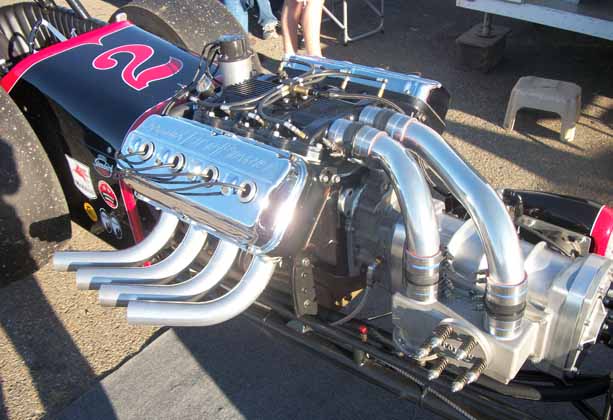Recently, I read a couple Hot Rod magazines from the 1950’s. In 1958, my favorite (mechanical fuel injection) propelled several Bonneville racers over 200 MPH. One went around 290 MPH. Those racer builders were the performance leaders of the time with amazing achievements!

Front mounted superchargers were common. Fuel splits of around 15 to 25% in the FI hat mounted on the blower inlet were common. The remainder, 75 to 85%, went into the port nozzles that were mounted on the engine after the blower. One setup was close to 10-90. That is so little fuel through the hat feeding the blower for cooling. I am amazed that such a dramatic fuel split was necessary. The fuel distribution was not good that came through those long chromed pipes leading from the blower on the front to the top of the engine. To compensate, most of the fuel was sent through the individual port nozzles closest to each cylinder.
Common blowers for front mounted setups were 4-71’s and the behemoth of the time was a 6-71 with a standard outlet. There was a lot of heating and extra pumping loss from reversion at the blower outlet. In addition, blowers were the standard Roots inlet & outlet that contributed to pumping losses. We now know there is a lot of fuel standoff at the inlet from a large opening as fuel is flung from the rotors. That is explained in our fuel injection, methanol, & nitro books. That led to the smaller supercharger openings of today to block the fuel standoff flinging off the rotors. It is interesting now that smaller is better. Yet they still screamed back then.
Excerpts from our book, 5000 Horsepower on Methanol
To better explain the difference between torque peak and horsepower peak of a racing engine the following excerpts are provided:
“17.2.3 AT THE TORQUE PEAK
The MIXTURE compression cycle and MECHANICAL compression cycle are the most synchronized at the torque peak. The intake valve is closing at the best time to trap the highest volume of air and fuel into the cylinder. Some of that filling occurs after the piston reaches BDC (BOTTOM DEAD CENTER — THE MECHANICAL CYCLE) from the mass inertia of the air and fuel still filling the cylinder. The highest amount of torque occurs from this synchronization.
17.2.4 AT THE HORSEPOWER PEAK
At optimum horsepower in a properly designed engine, those cycles may be further synchronized. A high intake cycle flow occurs in time with the downward movement of the piston combined with a high repetition rate for the most horsepower…”
Further explanation of the two peaks as they pertain to tuning is throughout this publication.
